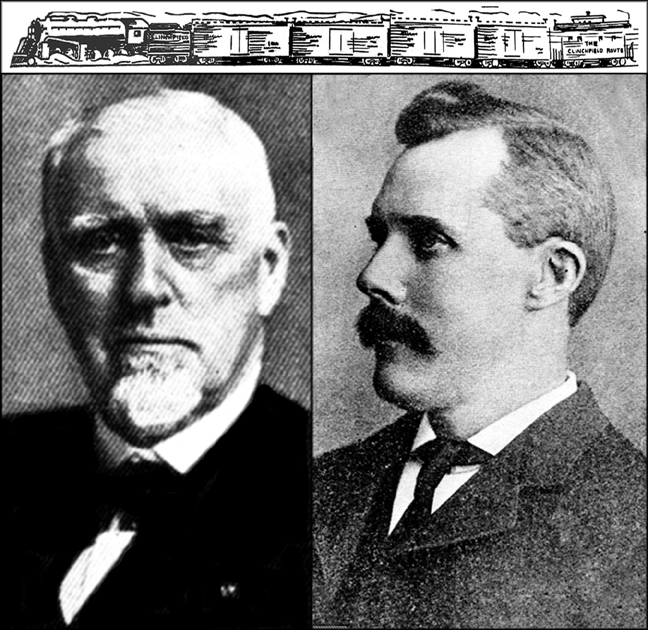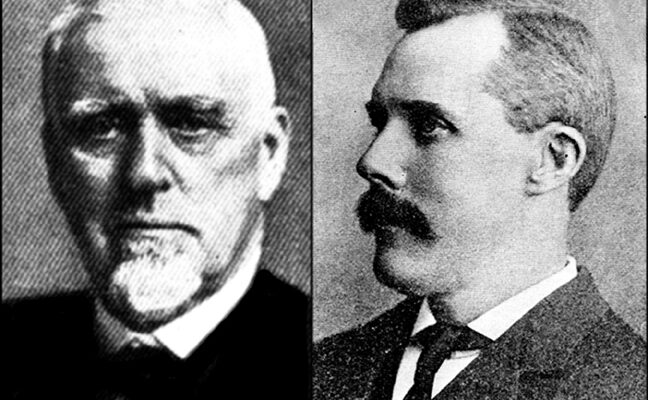Yesterday, September 30, 2012, marked the anniversary of a historical event that occurred 126 years ago. Two local history buffs met on September 30, 1986, the 100-year anniversary of the incident, and relived the story for an article for the Johnson City Press-Chronicle.
Jim Goforth (Erwin historian and author) and Tom Hodge (historian and Press-Chronicle writer) convened on that day in Tom’s office to revive the particulars of the granting of a charter to the Charleston, Cincinnati and Chicago Railroad, commonly referred to as the 3-C Railroad.
The two history buffs contrasted the 1886 exciting announcement of the construction of a much-needed railroad in Johnson City with the 1893 disparaging news that work was being suspended, even after much track had been laid.

L: John T. Wilder, R: George L. Carter
In 1886, ex-Union General John T. Wilder received a charter to build the 3-C Railroad, a forerunner of the Clinchfield. He already had other significant businesses in the city: the Carnegie Land Company, the Cranberry Iron Furnace, the Carnegie Hotel and the Cloudland Hotel (atop beautiful Roan Mountain).
While campaigning through the Southeast during the Civil War, the industrialist visualized great potential for developing the area, but he also realized that the region lacked an adequate transportation system. To remedy this, he received authorization to begin constructing a 625-mile railroad from Charleston, South Carolina to Cincinnati, Ohio to connect the industrial midwest with the Atlantic seaport. The new route would further serve the coalfields of Eastern Kentucky and Southwestern Virginia, the timber and mineral areas of East Tennessee and Western North Carolina, the resort areas of the Blue Ridge and the agricultural area of the Piedmont.
The estimated cost of the venture was $21 million, which was a considerable amount of money then. Within two years, a 171-mile segment from Camden, South Carolina to Marion, North Carolina was completed and put into service.
When the Carnegie section of Johnson City, near the Empire Furniture Company plant on E. Fairview Avenue, was chosen as the northern headquarters of the railroad, the city almost overnight became a boomtown. Track installation was expedited in both north and south directions from the city. Rails reached the Nolichucky River in Erwin in 1890 and the roadbed to Dante, Virginia was 90% completed three years later.
In 1893, the country suffered a depression, known as “Cleveland’s Panic,” and the 3-C Railroad immediately faced bankruptcy. Assets were sold at foreclosure for $550,000. Johnson City, eager to help reclaim the 3-C line, bought $70,000 worth of bonds, thereby subjecting the city to heavy financial strain when it defaulted.
A new owner, identified as the Ohio River and Charleston Railroad, acquired the assets in 1897, but unfortunately did little to extend the line. Conversely, the company began selling portions of it.
In 1902, a new hero emerged. George L. Carter acquired the northern segment of the road and completed construction as the Clinchfield Railroad. However, he abandoned much of the 3-C roadbed and instead laid new track to Johnson City from the northwest. Since the entrepreneur had become involved in developing the coal lands of southwestern Virginia, he needed a railroad to transport his coal to a south Atlantic seaport. Between 1905 and 1909, work to extend the Clinchfield from Dante, Virginia to Spartanburg, South Carolina was successfully completed.
A few years ago, Clint Isenberg, a Gray resident, showed me some weed-covered track near Spurgeon’s Island just off the old Kingsport highway. According to Tom and Jim in 1986, track could still be seen at the intersection of East Fairview Avenue and Star Mill Road and at the old J. Norton Arney Farm, which later became Winged Deer Park. Are there still portions of 3-C track visible in the area?
